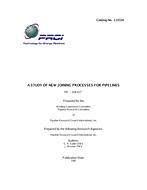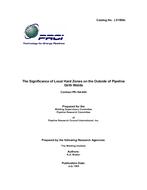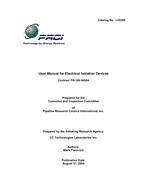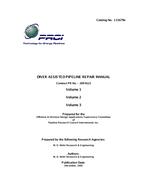Provide PDF Format
PRCI PR-164-517
- A Study of New Joining Processes For Pipelines
- Report / Survey by Pipeline Research Council International, 01/01/1987
- Publisher: PRCI
$348.00$695.00
L51534e
Pipeline Research Council International, Inc.
Need: Over many decades it has been accepted that the most economical way to produce a pipeline is to join together the standard lengths of pipe as quickly as possible, using a highly mobile task force of welders and other technicians, leaving tie-ins, crossings, etc. to smaller specialist crews. The work pattern which evolved almost invariably involved several crews of welders strung out along the pipelines, progress being controlled by the rate at which the leading pair could complete the weld root. The spread from this first crew to final inspection could be a considerable distance, acceptable on land but not acceptable offshore (a rapidly increasing need which reached a peak in the 1970's). This operation, involving costly lay barges, demanded even higher throughput rates to be achieved from a more compact working spread. In common with most manufacturing technologies, there was an increasing dissatisfaction with a system which relied entirely on the skill of a limited number of highly paid men who had little incentive to change their working practices. Increasingly there came reports of the development of new approaches to joining line-pipe, ranging from the mechanization of arc welding to entirely different forms of joining, for example, electron beam welding or mechanical joining. The investment in some of these developments is reported to be several million dollars. The review of present pipelining practice shows that only a handful has been put to practical use, and in the western world, probably only one, an arc welding variant, has been used to produce more than a few hundred miles of pipeline. The information available on these developments is sparse and is scattered amongst a range of companies and research agencies. A literature review and research study to collect together as much of this information as is available, assemble it into a coherent and useable form and identify those developments which show the most promise to fulfill future needs.
Result: The main body of the report, which reviews development of the welding processes has been divided into three main joining categories, Fusion Welding, Forge Welding and Mechanical Interference Joining. Within each category each process is considered separately in terms of process principles, general applications, application to pipeline welding, equipment for pipe welding, consumables, process tolerance and skill requirements, weld quality and inspection, process economics, limitations and future developments.
Benefit: The most important factor when deciding which of a number of technically acceptable processes is to be used is the overall economics. This study and comprehensive report compares the economics of the various alternatives. For each process an estimate has been made of the procedural and development costs involved as well as personnel needs and likely production rates.
Pipeline Research Council International, Inc.
Need: Over many decades it has been accepted that the most economical way to produce a pipeline is to join together the standard lengths of pipe as quickly as possible, using a highly mobile task force of welders and other technicians, leaving tie-ins, crossings, etc. to smaller specialist crews. The work pattern which evolved almost invariably involved several crews of welders strung out along the pipelines, progress being controlled by the rate at which the leading pair could complete the weld root. The spread from this first crew to final inspection could be a considerable distance, acceptable on land but not acceptable offshore (a rapidly increasing need which reached a peak in the 1970's). This operation, involving costly lay barges, demanded even higher throughput rates to be achieved from a more compact working spread. In common with most manufacturing technologies, there was an increasing dissatisfaction with a system which relied entirely on the skill of a limited number of highly paid men who had little incentive to change their working practices. Increasingly there came reports of the development of new approaches to joining line-pipe, ranging from the mechanization of arc welding to entirely different forms of joining, for example, electron beam welding or mechanical joining. The investment in some of these developments is reported to be several million dollars. The review of present pipelining practice shows that only a handful has been put to practical use, and in the western world, probably only one, an arc welding variant, has been used to produce more than a few hundred miles of pipeline. The information available on these developments is sparse and is scattered amongst a range of companies and research agencies. A literature review and research study to collect together as much of this information as is available, assemble it into a coherent and useable form and identify those developments which show the most promise to fulfill future needs.
Result: The main body of the report, which reviews development of the welding processes has been divided into three main joining categories, Fusion Welding, Forge Welding and Mechanical Interference Joining. Within each category each process is considered separately in terms of process principles, general applications, application to pipeline welding, equipment for pipe welding, consumables, process tolerance and skill requirements, weld quality and inspection, process economics, limitations and future developments.
Benefit: The most important factor when deciding which of a number of technically acceptable processes is to be used is the overall economics. This study and comprehensive report compares the economics of the various alternatives. For each process an estimate has been made of the procedural and development costs involved as well as personnel needs and likely production rates.





